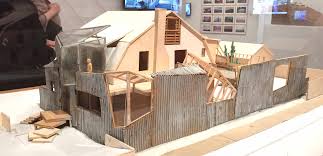- How does the change of point of view and person of narration alter the reader's perception of the narrated events?
- Compare the openings of both films.
- Is there any scene in the movie that helps you best visualize an event in the novel? Which and why?

The underground concealment, where they found food supply and warmth, scene in the movie, helps visualizing the colorful painting of hope. If it wasn't for that scene, they would not be able to make it. It was slightly the turnover point, where we see our main characters being thankful for what was granted to them. It was their chance to revalue their "luck" and get in touch with their humanity, or in other words, to express freedom for a few moments.
ReplyDeleteIn the book, we can only observe what it was happening through the man’s point of view, thus we more biased towards his opinion. In the movie, the viewer can form their own conclusions and opinions based on what’s happening while listening what the man has to say.
ReplyDeleteAssuming the second question is about the trailer and the movie, the trailer opening is much more colorful and more action-packed than the opening of the movie. It even explains what happened to the world in the story in one phrase while the movie only hinted at it.
The best scene that helped me visualize an event was when the man and the boy stumbled upon the naked people in the basement of a house. The ambiance and the music highlighted the horror aspect. Even though the world is gray and dying, there’s still horrific elements attached to the human element, not just nature itself.
O início da obra literária e sua adaptação cinematográfica são um pouco diferentes e penso que as alterações são resultado, principalmente, das naturais restrições temporais a que o filme está sujeito. Enquanto o leitor apenas tem acesso, desde logo, a uma América queimada e pilhada, o filme de Hillcoat começa por mostrar à sua audiência uma América familiar e luminosa, onde o Homem pode estabelecer uma relação próxima com a natureza benigna. Estes primeiros momentos do filme são de seguida contrastados com a paisagem cinzenta e árida onde as personagens se encontram. Desta forma, a audiência é capaz de estabelecer rapidamente uma ligação cronológica entre o presente da narrativa e o início dos eventos que transformaram a paisagem. Uma narração em “voiceover” fornece ao espectador diversas informações a que o leitor da obra apenas tem acesso de forma mais segmentada ao longo da narrativa. Assim, a história é contada mais rápida e economicamente, pois a informação não é extraída aos poucos pelo leitor, mas fornecida de imediato à audiência.
ReplyDeleteEsta narração inicial é feita na primeira pessoa, sendo que podemos classificar o narrador como sendo autodiegético. Classificação que contrasta com a narração na terceira pessoa do narrador heterodiegético da obra literária. Este, apesar de dar acesso às memórias e sonhos das personagens, não é omnisciente e não fornece descrições detalhadas da narrativa interna e estado psicológico das personagens, sendo que o leitor tem de inferir os sentimentos mais complexos a partir de elementos exteriores. Contudo, enquanto a narração na terceira pessoa e visão limitada do narrador contribuem para um certo distanciamento entre o leitor e as personagens, a narrativa na primeira pessoa do filme acaba por mitigar essa distância. Para além disso, o facto do narrador ser autodiegético contribui, possivelmente, para a criação, no espectador, de uma sensação de maior isolamento que não seria possível se uma terceira voz fosse introduzida.
For me one of the most pivotal events in the book happens when the boy and the man find two men and a pregnant woman and wonder who they are, if they are good or bad guys. They see them walking aimlessly in the night towards the darkness. On the next day they see smoke rising above the trees in the woods and they smell something cooking. When they approach the clearing they spot some tree trunks burning and when the man is checking the perimeter the boy sees the remains of a baby on the spit and goes to his father, "buried his face against him". The description in the book of this sequence is harrowing. The event is important because it shows the reader the complete opposite of the man and the boy, it shows just how far some people are willing to go to survive. However, in the film this scene doesn't exist, I can understand why, the movie is already quite somber and having this scene in the film would make it even less marketable that it already was.
ReplyDeleteGonçalo Castro